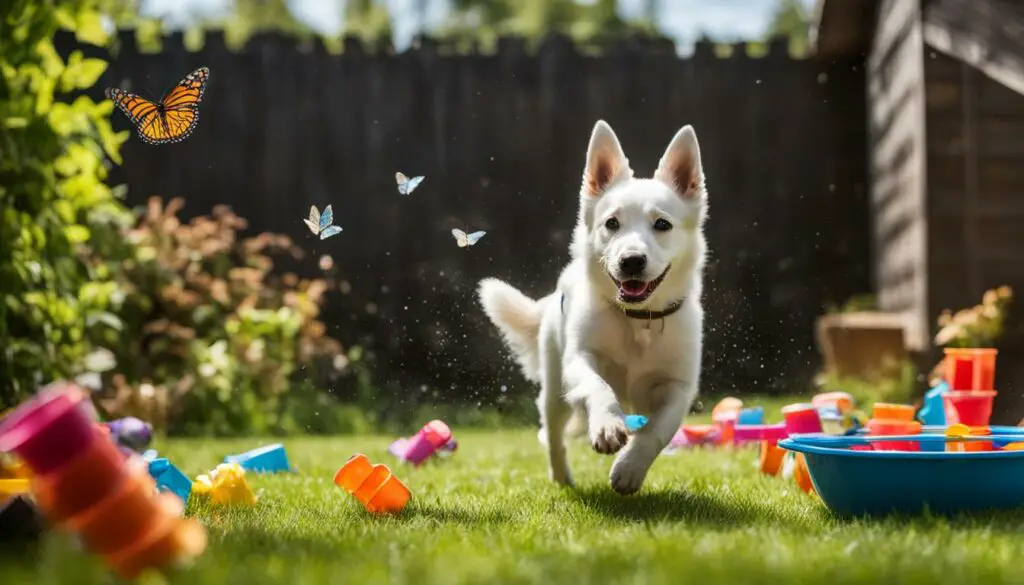Have you ever wondered why your furry friend gets so excited? It’s a common question among pet owners, and understanding the reasons behind your dog’s excitement can help you better manage their energy levels.
Dogs have a natural tendency to become enthusiastic and energetic, but what causes this behavior? There are several factors that contribute to a dog’s excitement levels, including their instincts, environmental stimuli, and individual temperament. By uncovering these triggers, you can find effective ways to channel their energy and promote a balanced and calm demeanor.
Key Takeaways:
- Dogs become excited due to their instincts, environmental stimuli, and individual temperament.
- Understanding the reasons behind your dog’s excitement can help you manage their energy levels effectively.
- Regular exercise and mental stimulation are essential for managing your dog’s excitement.
- Socialization plays a significant role in controlling your dog’s excitement levels.
- Positive reinforcement and training techniques are valuable tools for calming an excited dog.
The Role of Instincts in Dog Excitement
When trying to understand why our dogs get so excited, it’s important to recognize the role that instincts play in their behavior. Dogs have a strong natural inclination towards various activities that trigger their senses and fulfill their instinctual needs. These instincts have been passed down from their wild ancestors and contribute to their excitement levels.
One of the primary instinctual needs of dogs is physical activity. They have a natural desire to run, jump, and play, which helps them release their energy and maintain a healthy state of mind. Regular exercise is essential for managing their excitement levels and preventing excessive or inappropriate behaviors.
Social interaction is another instinctual need that drives a dog’s excitement. Dogs are social animals and thrive on companionship. They enjoy interacting with humans and other animals, which stimulates their senses and fulfills their social needs. Proper socialization from an early age helps dogs develop appropriate behaviors and responses in different social situations, ultimately helping them regulate their excitement and interact calmly with others.
| Instincts in Dog Excitement | Role |
|---|---|
| Physical activity | Helps release energy and maintain a healthy state of mind |
| Social interaction | Stimulates senses and fulfills social needs |
Instincts drive a dog’s excitement and contribute to their overall behavior. By fulfilling their instinctual needs for physical activity and social interaction, we can help manage their excitement levels and promote a balanced state of mind.
Understanding and recognizing these instincts in dogs can help pet owners provide appropriate outlets for their excitement and prevent behavioral issues. By incorporating regular exercise, socialization, and interactive play into their daily routines, we can help our furry friends lead happy and fulfilling lives.
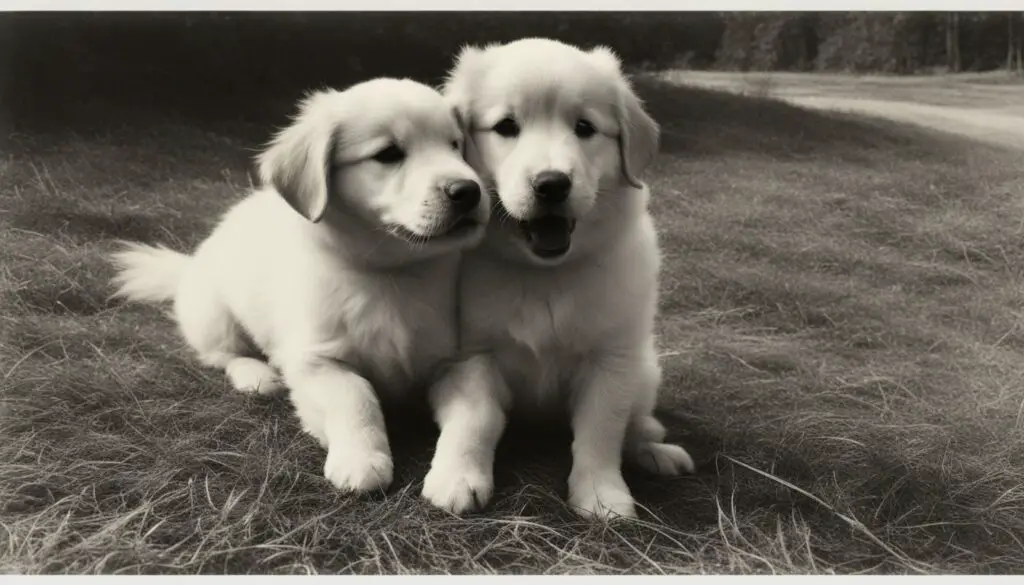
Conclusion
Instincts play a crucial role in a dog’s excitement levels. By understanding their natural needs for physical activity and social interaction, we can effectively manage their excitement and promote a balanced state of mind. Providing plenty of exercise, socialization opportunities, and interactive playtime helps fulfill their instincts and keeps them engaged, happy, and well-behaved.
Environmental Stimuli and Dog Excitement
Environmental stimuli play a significant role in triggering dog excitement and can lead to various behaviors when a dog becomes overly excited. Dogs are highly sensitive to their surroundings, and certain stimuli can cause them to react with excitement, whether it be through hyperactive behavior, barking, or jumping. It is important for pet owners to recognize and understand these triggers in order to effectively manage their dog’s excitement levels and promote a calm and balanced state of mind.
One common environmental stimulus that can excite dogs is the presence of other animals. The sight, smell, or sound of another animal can immediately trigger excitement, especially if the dog has a strong prey drive or a desire to play. Additionally, new smells or changes in routine can also stimulate a dog’s excitement. Dogs rely heavily on their sense of smell, and the introduction of new scents can be highly stimulating for them.
Loud noises are another common environmental stimulus that can cause dogs to become excited. The sudden sound of a doorbell, fireworks, or even a vacuum cleaner can startle a dog and result in heightened excitement or anxiety. It is important for pet owners to provide a secure and quiet space for their dogs to retreat to when they become overwhelmed by loud noises.
The individual temperament of a dog also plays a role in how they respond to environmental stimuli. Some dogs may be more prone to excitement than others due to their genetic predisposition or previous experiences. Understanding a dog’s unique temperament can help pet owners anticipate and manage their dog’s excitement more effectively.
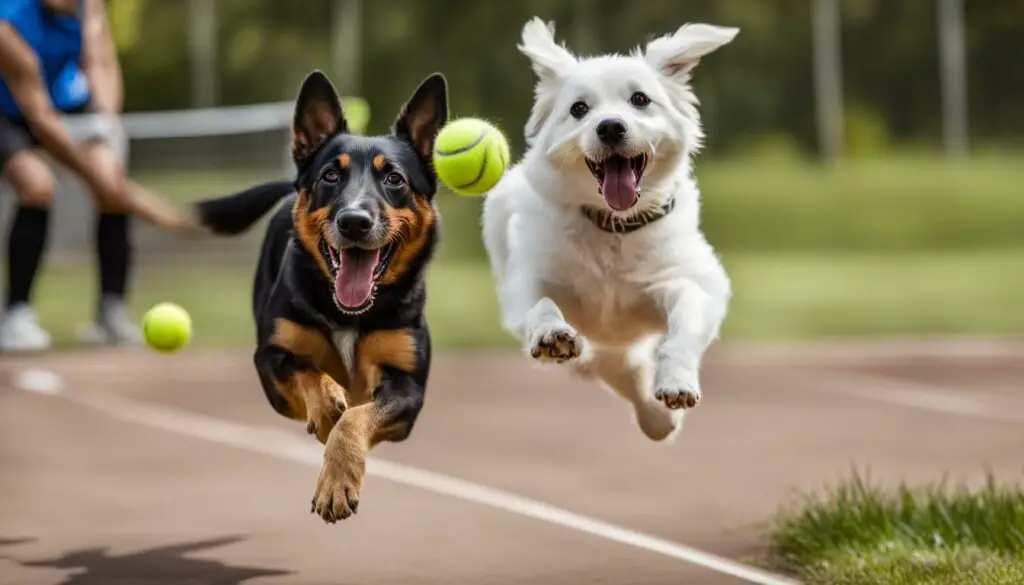
The Impact of Environmental Stimuli on Dog Behavior
Different dogs may exhibit various behaviors when they become excited. While some dogs may display hyperactive tendencies such as jumping, barking, or spinning, others may become anxious or exhibit destructive behaviors. It is essential for pet owners to remain calm and provide a structured environment to help their dogs calm down and regain control.
A well-structured environment and consistent routines can help dogs feel secure and minimize excessive excitement.” – Dr. Emily Johnson, Canine Behavior Specialist
Creating a calm and structured environment involves providing regular exercise, mental stimulation, and a predictable routine. Ensuring that a dog’s basic needs are met, such as regular feeding and rest, can significantly reduce their overall excitement levels. Additionally, engaging in calming activities such as gentle massages or using calming pheromone diffusers can help relax an excited dog.
In summary, environmental stimuli can greatly influence a dog’s excitement levels and behavior. By understanding the triggers that excite your dog and providing a structured and calm environment, you can effectively manage their excitement and promote a balanced state of mind.
The Benefits of Exercise for Managing Dog Excitement
Exercise plays a crucial role in managing a dog’s excitement levels. Regular physical activity helps dogs burn off excess energy, release endorphins, and promote a calmer state of mind. Providing daily exercise, such as walks, runs, or play sessions, can help prevent boredom, reduce anxiety, and channel their energy in a positive way.
In addition to physical exercise, mental stimulation also plays a vital role in managing dog excitement. Interactive toys, training exercises, and puzzle games can help tire out a dog mentally and keep their excitement levels in check. Mental stimulation challenges their problem-solving skills and helps them focus their energy in a constructive and controlled manner.
| Benefits of Exercise for Managing Dog Excitement |
|---|
| 1. Burns off excess energy |
| 2. Releases endorphins for a calmer state of mind |
| 3. Prevents boredom and reduces anxiety |
| 4. Channels energy in a positive way |
| 5. Provides mental stimulation through interactive toys and training exercises |
| 6. Challenges problem-solving skills for a focused and controlled mindset |
Remember to tailor the amount and type of exercise to your dog’s age, breed, and overall health. Consult with a veterinarian or professional dog trainer to determine the appropriate exercise regimen for your furry friend. Incorporating regular physical and mental exercises into your dog’s routine will help manage their excitement and promote a balanced and healthy lifestyle.
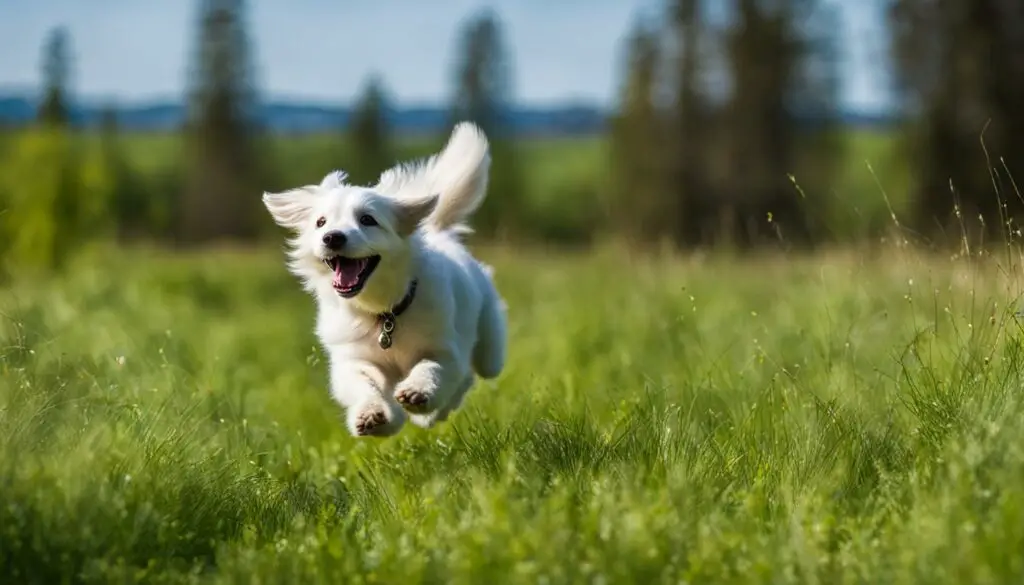
Understanding the Role of Socialization in Dog Excitement
Socialization is a critical aspect of managing a dog’s excitement levels. Dogs are naturally social animals, and their interaction with humans and other animals plays a significant role in their overall behavior and temperament. Adequate socialization helps dogs develop appropriate responses and behaviors in different social situations, including managing their excitement.
Proper socialization should begin at an early age to ensure that dogs grow up to be well-adjusted and confident. Puppies should be exposed to various environments, people, and animals in a controlled and positive manner. This exposure helps them become familiar with different sights, sounds, and smells, reducing the likelihood of fear or overexcitement in unfamiliar situations.
During socialization, it is important to provide positive experiences and reinforce calm and controlled behavior. Rewarding calmness and appropriate interaction with treats, praise, or play can help dogs associate positive feelings with socialization. Additionally, gradually exposing dogs to new and potentially stimulating environments or experiences can help them learn to regulate their excitement and respond calmly.
Creating a Structured Socialization Routine
- Expose your dog to a variety of environments, including parks, pet-friendly events, and different types of surfaces (grass, concrete, etc.), to help them become comfortable in different settings.
- Introduce your dog to well-behaved and vaccinated dogs to encourage positive social interactions.
- Invite friends and family members to visit your home and interact with your dog in a calm and controlled manner. This helps your dog learn to be comfortable with new people.
- Enroll your dog in puppy classes or obedience training, where they can interact with other dogs and learn basic commands in a supervised environment.
Quote: “Socialization is key to raising a well-behaved and balanced dog. By exposing them to positive experiences and teaching them appropriate behavior, we can help them manage their excitement in social situations.” – Professional Dog Trainer
Remember that socialization is an ongoing process. Regularly exposing your dog to new experiences and reinforcing positive behavior can help them develop lifelong social skills. A properly socialized dog is more likely to have manageable excitement levels, making them a joy to be around in various social settings.
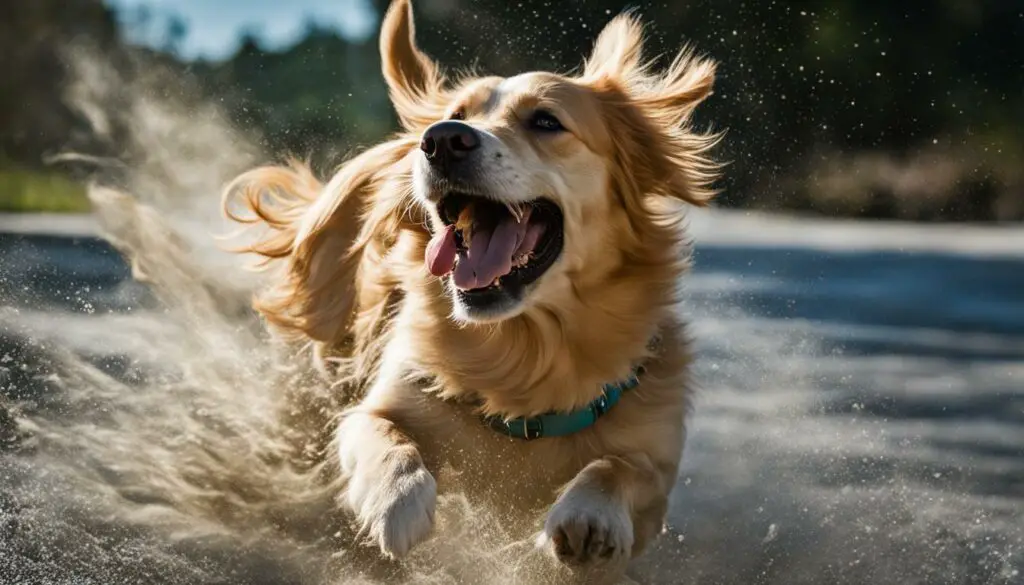
Tips for Calming an Excited Dog
Calming an excited dog can be a challenging task, but with the right techniques and consistency, you can help your furry friend find their inner calm. Here are some tips to help you manage and reduce your dog’s excitement levels:
Establish a Consistent Routine
Dogs thrive on routine and structure. By establishing a consistent daily routine, you can help your dog understand what is expected of them and reduce their anxiety or overexcitement. Set regular times for feeding, exercise, and rest, and stick to them as closely as possible. Consistency and predictability will provide a sense of security and help your dog feel more calm and balanced.
Use Positive Reinforcement
Positive reinforcement is a powerful training tool that can help calm an excited dog. Whenever your dog exhibits calm and controlled behavior, reward them with praise, treats, or their favorite toy. This positive association will reinforce the desired behavior and motivate your dog to repeat it. Avoid punishing or scolding your dog for their excitement, as this may increase their anxiety and make the situation worse.
Create a Calm Environment
Creating a calm and soothing environment can help your dog relax and reduce their excitement. Provide a quiet space where your dog can retreat and feel safe, such as a designated corner or a comfortable crate. Use soothing music or white noise to drown out loud noises that may trigger their excitement. Additionally, consider using a pheromone diffuser or calming supplements recommended by your veterinarian to help promote a sense of relaxation.
Remember, every dog is unique, and what works for one may not work for another. It’s essential to understand your dog’s individual needs, temperament, and triggers. If you’re struggling to manage your dog’s excitement or need additional guidance, consult with a professional dog trainer or behaviorist who can provide personalized advice and support.

The Importance of Mental Stimulation in Managing Dog Excitement
When it comes to managing a dog’s excitement levels, many people focus solely on physical exercise. While exercise is important, mental stimulation also plays a crucial role in keeping dogs calm and balanced. Engaging a dog’s mind through training sessions, interactive toys, and puzzle games can tire them out mentally and prevent boredom or restlessness.
Mental stimulation challenges a dog’s problem-solving skills and helps them channel their energy in a constructive and controlled manner. By providing regular mental exercises, pet owners can help their dogs use their brains and focus their energy on positive activities. This can be especially beneficial for high-energy breeds or dogs that are prone to excessive excitement.
“Mental stimulation challenges a dog’s problem-solving skills and helps them channel their energy in a constructive and controlled manner.”
One way to incorporate mental stimulation into a dog’s routine is through training. Training sessions not only teach dogs new skills and commands but also help them learn self-control and impulse management. Basic obedience training, such as teaching commands like “sit,” “stay,” and “leave it,” can help dogs focus their energy and respond calmly when they become excited.
Another way to provide mental stimulation is through interactive toys and puzzle games. These toys require dogs to use their problem-solving abilities to access treats or toys hidden inside. This not only keeps them engaged but also helps tire them out mentally. There are various puzzle toys available on the market, ranging from simple to more complex, so pet owners can choose the level of difficulty that suits their dog’s abilities.
The Benefits of Mental Stimulation in Managing Dog Excitement:
- Prevents boredom and restlessness
- Tires dogs out mentally
- Helps channel energy in a controlled manner
- Improves problem-solving skills
- Strengthens the bond between dog and owner
Overall, incorporating mental stimulation into a dog’s routine is essential for managing their excitement levels. By engaging their minds and providing opportunities for problem-solving, pet owners can help their dogs lead balanced and fulfilled lives.
| Exercise | Mental Stimulation |
|---|---|
| Helps burn off excess energy | Challenges problem-solving skills |
| Releases endorphins | Prevents boredom and restlessness |
| Promotes a calmer state of mind | Strengthens the bond between dog and owner |
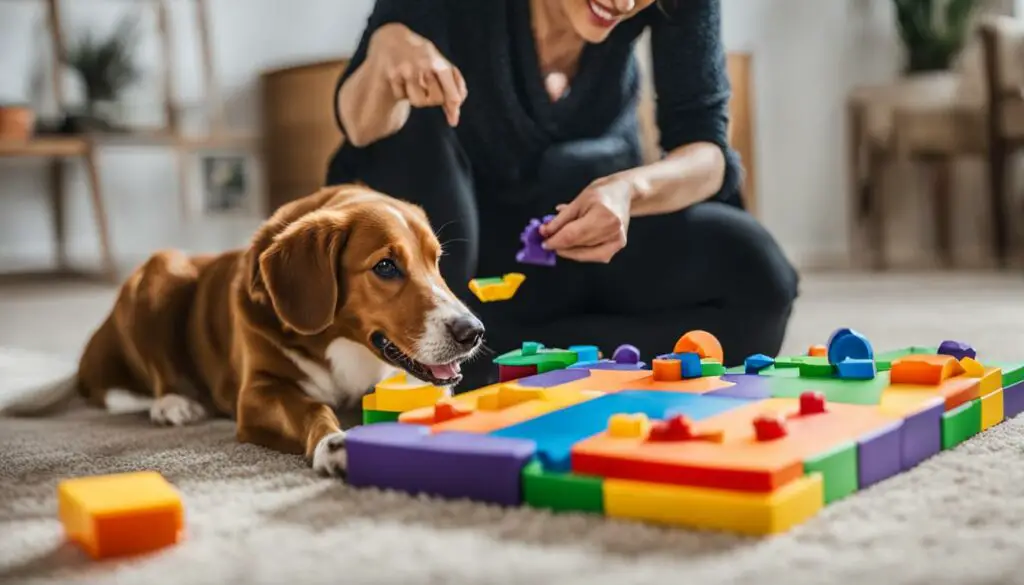
Recognizing and Addressing Excessive Dog Excitement
Excessive dog excitement can lead to a variety of unwanted behaviors, including jumping, barking, and destructive tendencies. It is important for pet owners to be able to recognize these behaviors and take appropriate steps to address them. By understanding the underlying causes of excessive excitement and implementing proper training techniques, pet owners can help their dogs manage their energy levels and maintain a calm demeanor.
One common cause of excessive dog excitement is a lack of proper socialization. Dogs that have not been exposed to different people, animals, and environments may become overly excited or anxious when faced with new stimuli. By gradually introducing dogs to new experiences and providing positive reinforcement for calm behavior, pet owners can help their dogs become more comfortable and less reactive in various situations.
“Socialization plays a significant role in a dog’s excitement levels. Proper socialization from an early age helps dogs develop appropriate behaviors and responses in different social situations.”
Another factor that contributes to excessive dog excitement is the lack of mental and physical stimulation. Dogs are intelligent animals that require both mental and physical exercise to stay balanced. Providing interactive toys, puzzle games, and regular training sessions can help engage a dog’s mind and tire them out, reducing their overall excitement levels. Additionally, ensuring that dogs receive regular exercise through walks, runs, or playtime can help release pent-up energy and prevent excessive excitement.
When addressing excessive dog excitement, it is important to focus on positive reinforcement training techniques. Punishment or harsh corrections can lead to increased anxiety and fear, exacerbating the problem. Instead, rewarding calm behavior and redirecting the dog’s focus to more appropriate activities can help them learn how to manage their excitement in a positive way. Seeking guidance from a professional dog trainer or behaviorist may also be beneficial in addressing severe cases of excessive dog excitement.
| Causes of Excessive Dog Excitement | Management Strategies |
|---|---|
| Lack of socialization | Gradual exposure to new stimuli, positive reinforcement for calm behavior |
| Lack of mental and physical stimulation | Interactive toys, puzzle games, regular training sessions, daily exercise |
| Improper training methods | Positive reinforcement techniques, rewarding calm behavior, redirecting focus |
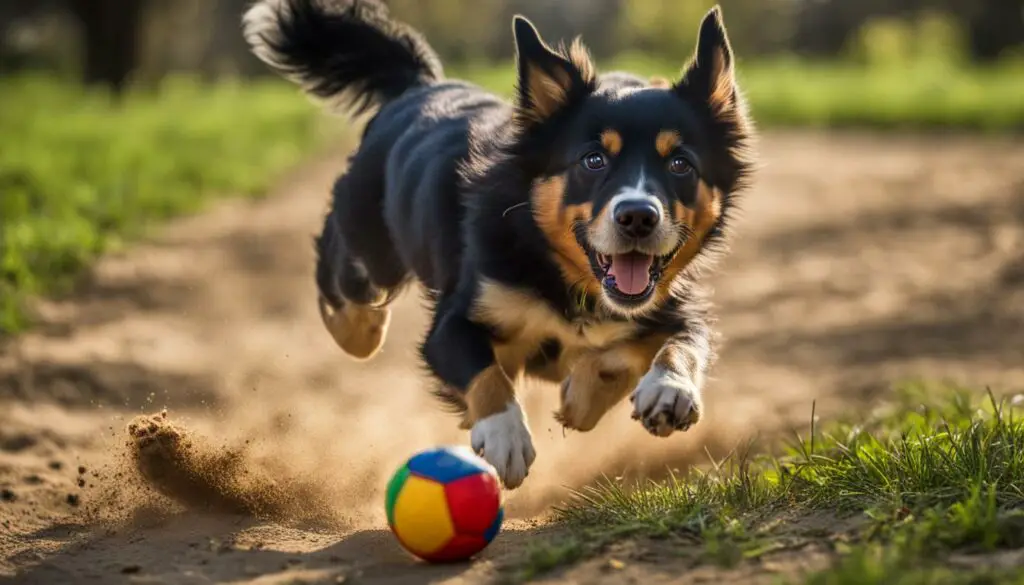
Summary
Excessive dog excitement can be managed through proper socialization, mental and physical stimulation, and positive reinforcement training techniques. By gradually exposing dogs to new experiences, providing engaging activities, and rewarding calm behavior, pet owners can help their dogs maintain a balanced and calm demeanor. It is important to address excessive dog excitement early on to prevent the development of unwanted behaviors and promote a harmonious relationship between pet owners and their dogs.
The Role of Positive Reinforcement in Managing Dog Excitement
When it comes to managing a dog’s excitement, positive reinforcement is an invaluable tool. By rewarding desired behaviors and reinforcing positive associations, pet owners can effectively encourage their dogs to exhibit calm and controlled behavior. Treats, praise, and affection are all fantastic rewards that can be used to reinforce calmness and appropriate interaction.
Consistency and patience are key when implementing positive reinforcement techniques. Dogs need time to learn and adjust their behaviors, so it’s important to provide clear cues and expectations. By establishing a consistent routine and using rewards to reinforce calm behavior, pet owners can help their dogs understand what is expected of them.
“Positive reinforcement is a powerful tool for managing dog excitement.”
Using positive reinforcement to manage dog excitement can be as simple as rewarding a dog for sitting calmly, instead of jumping up. By consistently rewarding calm behavior, dogs learn that calmness is a desirable and rewarding state. Over time, they will begin to exhibit more controlled behaviors in situations that would typically trigger excitement.
Promoting desired behaviors through positive reinforcement
- Reward calmness: When your dog remains calm in an exciting situation, reward them with treats or praise to reinforce the calm behavior.
- Redirect focus: If your dog becomes overly excited, redirect their attention to a preferred activity or toy to help them calm down.
- Establish clear expectations: Use consistent cues and commands to help your dog understand what behaviors are desired and rewarded.
- Be patient: Positive reinforcement takes time and consistency. Be patient with your dog as they learn and adjust their behaviors.
Remember, positive reinforcement is not only effective but also promotes a strong bond between pet owners and their dogs. By using rewards to reinforce calmness and appropriate behavior, pet owners can effectively manage their dog’s excitement levels and create a harmonious environment for both themselves and their furry companions.
Channeling Dog Excitement Through Training
Training is a vital tool in managing a dog’s excitement levels and promoting desired behaviors. By teaching dogs self-control, impulse management, and appropriate responses, we can help them channel their excitement in a positive and controlled manner. Basic obedience training is an excellent foundation for managing excitement. Commands such as “sit,” “stay,” and “leave it” can teach dogs to focus their energy and respond calmly when they become excited. The use of positive reinforcement techniques, such as treats and praise, helps reinforce calm and controlled behavior.
Consistency is key when it comes to training. Dogs need clear expectations and cues to help them understand what is desired of them. Establishing a consistent routine and providing clear guidelines for behavior can reduce anxiety and overexcitement. It is also essential to train dogs in a calm and controlled environment to help them stay focused and engaged.
Training should be a fun and interactive experience for both dogs and their owners. Incorporating games and interactive exercises into training sessions can help keep dogs mentally stimulated and tire them out. Mental stimulation challenges their problem-solving skills and helps redirect their energy. This can be achieved through puzzle toys, scent games, or obedience exercises that require them to think and respond.
Seeking guidance from a professional dog trainer or behaviorist can be beneficial, especially for addressing severe cases of excessive dog excitement. They can provide personalized advice and techniques tailored to your dog’s specific needs. Remember that training takes time and patience. Consistency, positive reinforcement, and a calm training environment are key to successfully channeling a dog’s excitement through training.
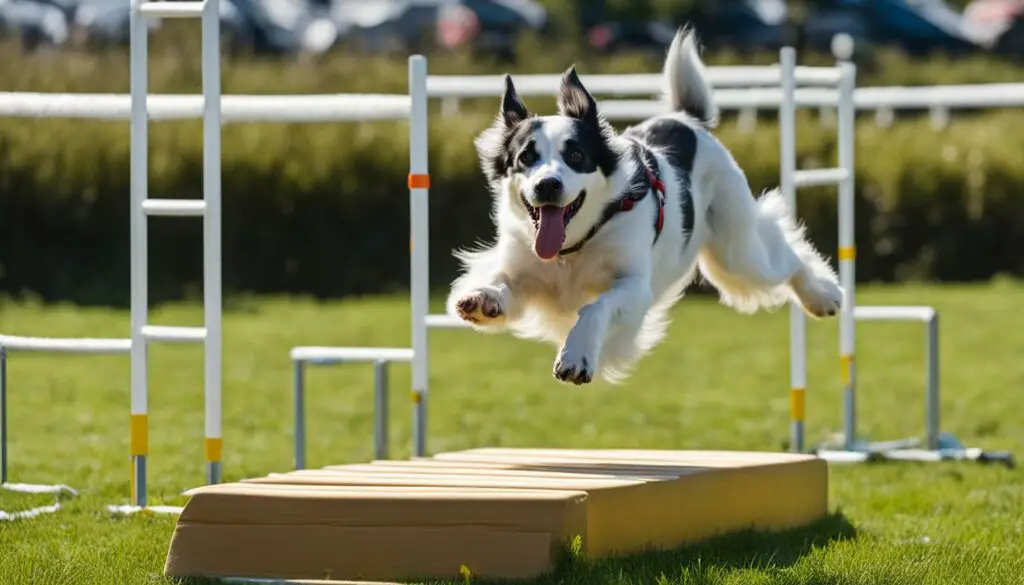
| Training Tips | Benefits |
|---|---|
| Use positive reinforcement techniques | Reinforces positive associations with calm behavior |
| Establish a consistent routine | Reduces anxiety and overexcitement |
| Incorporate mental stimulation in training | Tires out dogs mentally and redirects their energy |
| Seek professional guidance if needed | Personalized advice and techniques for your dog |
Addressing Specific Dog Breeds and Their Excitability
Understanding the unique characteristics and energy levels of different dog breeds is essential when it comes to managing their excitement levels. Some breeds are naturally more prone to excitement than others, and recognizing these breed-specific traits can help pet owners provide the right care and stimulation for their furry friends. Here, we will explore some common breeds and their typical excitement levels.
High-energy Breeds:
Labrador Retrievers, Border Collies, and Australian Shepherds are known for their boundless energy and enthusiasm. These breeds require plenty of exercise and mental stimulation to keep them engaged and prevent excessive excitement. Regular walks, runs, and playtime are essential for channeling their energy in a positive way.
Average-energy Breeds:
Golden Retrievers, Beagles, and Boxers fall into this category. While they may not have the same high-energy levels as some breeds, they still require regular exercise and mental stimulation to keep them content and prevent boredom-related excitement. Providing interactive toys and engaging in training sessions can help keep their minds occupied.
Low-energy Breeds:
Basset Hounds, Bulldogs, and Cavalier King Charles Spaniels are examples of breeds with lower energy levels. While they may not require as much exercise as higher-energy breeds, they still benefit from daily walks and mental stimulation. It’s important to strike a balance between providing enough activity to keep them physically healthy while also understanding their individual needs.
| Breed | Energy Level |
|---|---|
| Labrador Retriever | High |
| Border Collie | High |
| Australian Shepherd | High |
| Golden Retriever | Average |
| Beagle | Average |
| Boxer | Average |
| Basset Hound | Low |
| Bulldog | Low |
| Cavalier King Charles Spaniel | Low |
While these generalizations can provide a starting point, it’s important to remember that each dog is an individual. Factors such as training, socialization, and specific personality traits can all influence a dog’s excitement levels. By understanding your dog’s breed characteristics and tailoring their exercise and mental stimulation needs accordingly, you can help them lead a happy and balanced life.
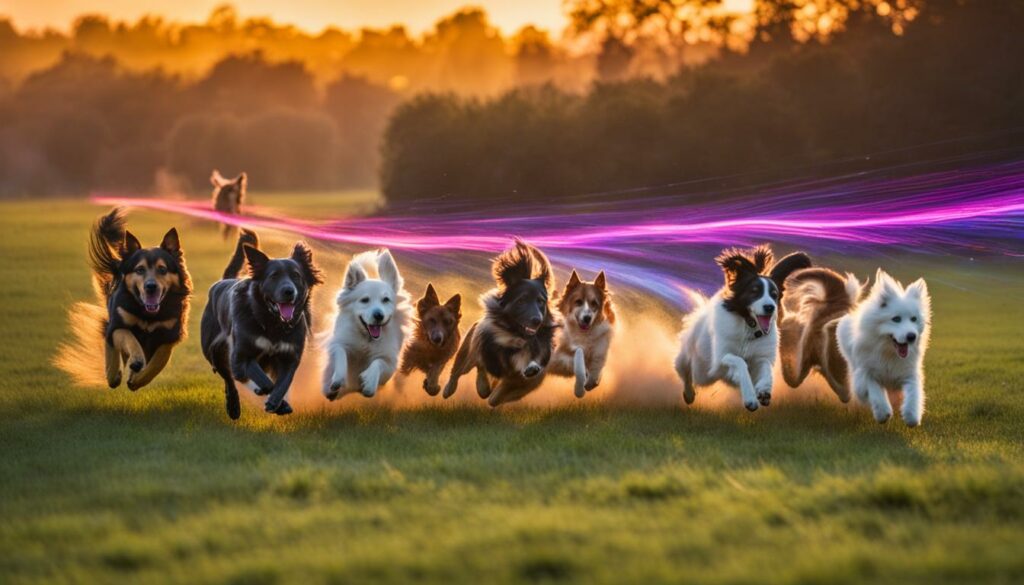
The Role of Age in Dog Excitement
Age plays a significant role in a dog’s excitement levels. Puppies and young dogs tend to have boundless energy and may exhibit exuberant behaviors that can be challenging for pet owners to manage. As dogs mature, their energy levels and excitement may naturally decrease, but it is still important to provide them with regular exercise, mental stimulation, and training throughout their lives.
Older dogs may have different exercise needs due to physical limitations or age-related changes. It’s crucial to adapt their exercise routines accordingly to prevent overexertion and discomfort. Consulting with a veterinarian can help determine the appropriate level of activity and any necessary modifications. Additionally, older dogs may benefit from activities that focus more on mental stimulation, such as puzzle toys or gentle training exercises.
The Importance of Adjusting Exercise for Older Dogs
When it comes to managing a dog’s excitement, it’s important to adjust exercise routines based on their age. Older dogs may experience arthritis or joint stiffness, so low-impact activities like swimming or slow walks can be beneficial. It’s also important to pay attention to their energy levels and provide them with ample rest periods throughout the day. By providing age-appropriate exercise and rest, pet owners can help maintain a balanced state of mind and overall well-being in their older dogs.
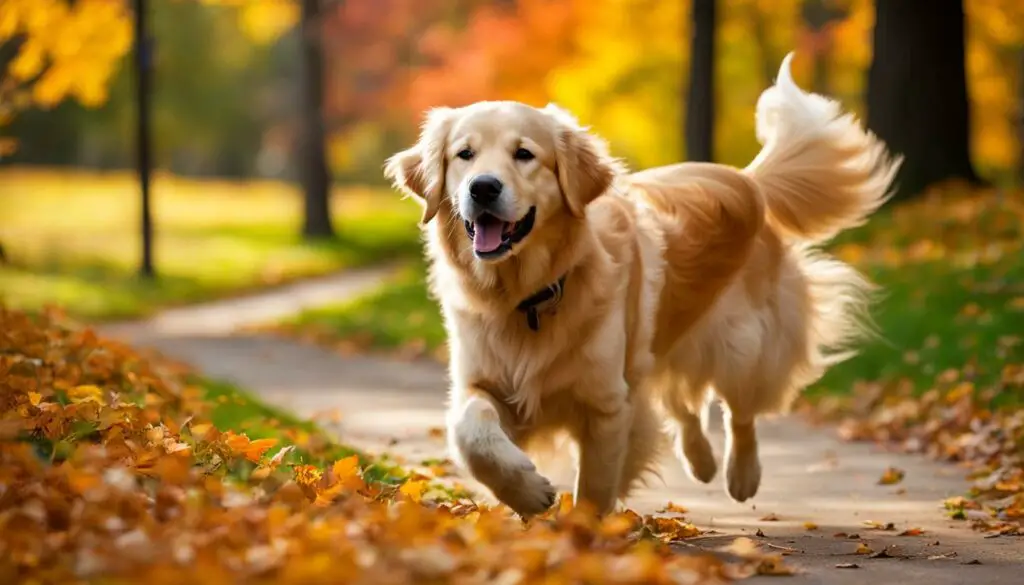
| Age Group | Exercise Recommendations |
|---|---|
| Puppies | Short, frequent bursts of play and exercise to accommodate their short attention spans and growing bodies. Focus on proper socialization and basic training. |
| Adult Dogs | Moderate to high-intensity exercise such as brisk walks, runs, or interactive play sessions. Mental stimulation through training exercises and puzzle toys should also be included. |
| Senior Dogs | Low-impact activities like swimming, gentle walks, or slow-paced games. Focus on mental stimulation through training exercises and interactive toys designed for older dogs. |
As dogs age, it’s important to remember that their exercise needs may change. Adjusting their exercise routines and providing appropriate mental stimulation can help manage their excitement and ensure a happy and healthy life. By understanding the role of age in dog excitement and tailoring activities to meet their specific needs, pet owners can help their furry companions age gracefully and comfortably.
Conclusion
Understanding why your dog is so excited is crucial in managing their energy levels and promoting a balanced state of mind. Dogs become excited due to various factors, including their instincts, environmental stimuli, and individual temperament. By identifying these triggers, you can find effective ways to channel your dog’s excitement and prevent excessive or inappropriate behaviors.
One key factor in managing dog excitement is providing regular exercise and mental stimulation. Physical activity helps dogs burn off excess energy and release endorphins, while mental exercises challenge their problem-solving skills. Incorporating both into their routine helps tire them out and prevents boredom or restlessness.
Training your dog also plays a significant role in managing their excitement levels. Through obedience training and positive reinforcement, dogs learn self-control, impulse management, and appropriate responses to different situations. Consistency, patience, and a calm environment are key in effectively channeling their excitement and promoting desired behaviors.
Lastly, be aware of breed-specific characteristics and age-related changes. Different breeds have different energy levels and temperaments, which can affect their excitement levels. Similarly, puppies and young dogs may exhibit more exuberant behaviors, while older dogs may have different exercise needs. Adapting their routine to accommodate these factors ensures a balanced and happy life for your furry friend.
FAQ
Why is my dog so excited?
Dogs can become excited due to various factors, including their instincts, environmental stimuli, and individual temperament.
How do I manage my dog’s excitement levels?
To manage your dog’s excitement, you can fulfill their instinctual needs, provide regular exercise and mental stimulation, and establish a consistent routine.
What are some common triggers for dog excitement?
Dogs can become excited in response to environmental stimuli such as other animals, new smells, loud noises, or changes in routine.
How can I calm down an excited dog?
Calming an excited dog requires training, patience, and appropriate techniques such as establishing routines, using positive reinforcement, and providing a quiet and safe space.
Why is it important to exercise my dog to manage their excitement?
Regular exercise helps dogs burn off excess energy, release endorphins, and promote a calmer state of mind.
How does socialization impact a dog’s excitement levels?
Proper socialization helps dogs develop appropriate behaviors, regulate their excitement, and interact calmly with others.
How can I incorporate mental stimulation into my dog’s routine?
Engaging your dog’s mind through training sessions, interactive toys, or puzzle games can tire them out mentally and prevent restlessness or boredom.
What should I do if my dog’s excitement becomes excessive?
If your dog’s excitement escalates or becomes excessive, techniques such as desensitization, counter-conditioning, and impulse control training can be helpful. Seeking professional guidance may also be necessary.
How can positive reinforcement help manage dog excitement?
Positive reinforcement, such as rewarding calm behavior or appropriate interaction, encourages dogs to repeat those behaviors and reinforces positive associations.
What role does training play in managing dog excitement?
Training helps dogs learn self-control, impulse management, and appropriate responses to different situations. Basic obedience training can help dogs focus their energy and respond calmly when excited.
Do different dog breeds have different levels of excitement?
Yes, different dog breeds have varying energy levels and temperaments, which can affect their excitement levels.
How does age impact a dog’s excitement?
Puppies and young dogs tend to have higher energy levels and may exhibit more exuberant behaviors. Older dogs may have different exercise needs and require modifications to their routine.

